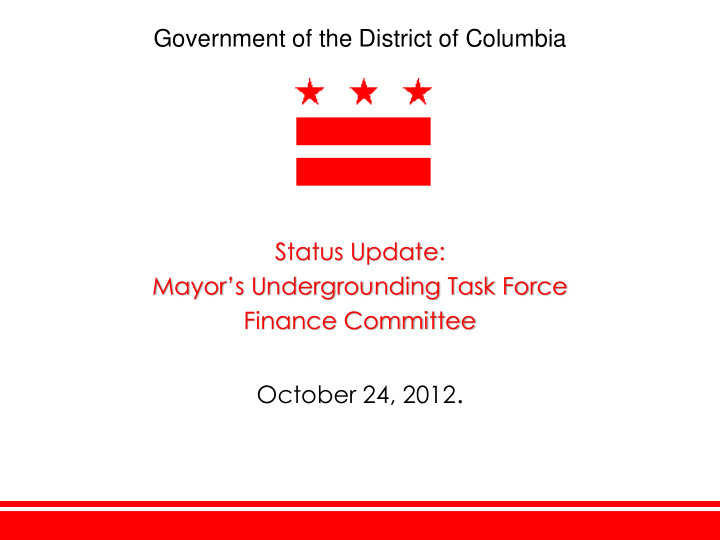



Government of the District of Columbia Status Update: Mayor’s Undergrounding Task Force Finance Committee October 24, 2012 .
• The Committee is examining project scenarios that are similar in scope to Options 2 and 3 of the Shaw report, which should result a 65-87% reduction in District-wide customer outages • Prioritization of individual Mainline, Lateral and Secondary lines for undergrounding will be determined initially by the Technical Committee and then by a formal approval process
• Three general financing schemes were investigated by Finance Committee – Pay As You Go (Cash Flow) – Third-Party Financing – Utility Securitization
• Utility uses surcharge to finance construction costs as incurred • Pros: – Low financing costs, limited to short-term borrowing costs – Maximum flexibility for construction and procurement • Cons: – Limits ability to bring improvements on-line quickly without significant surcharges – Better for smaller scope and longer timeline (i.e., 20 year construction schedule)
• Debt-Supported Contribution in Aid of Construction (CIAC) – Long-term debt – Ratepayer surcharge to support • Pros: – Payments spread over a long period – Construction period not tied to payment period • Cons: – Higher cost – Controls needed to insure proceeds are earmarked strictly for undergrounding project
Securitization refers to Laws and Commission Orders needed to set- aside (“secure”) a stream of ratepayer fees that are dedicated to paying off bonds issued by a separate entity protected from utility bankruptcy – Utility serves as a collection agent for the fees – Commission cannot change the Financing Order – Legislature cannot amend the authorizing statute – Approximately 20 states allow for utility securitization
• Pros: – Very low cost of borrowing (AAA rating); – No equity return for utility also lowers financing costs – Very low risk • Cons: – Inflexible: Requires enabling legislation and financing opinion that cannot be changed regardless of changing circumstances – Total borrowing may be limited to 15-20% of total Utility rate base (if so, could not finance a project of this scope in its entirety)
Recommend
More recommend